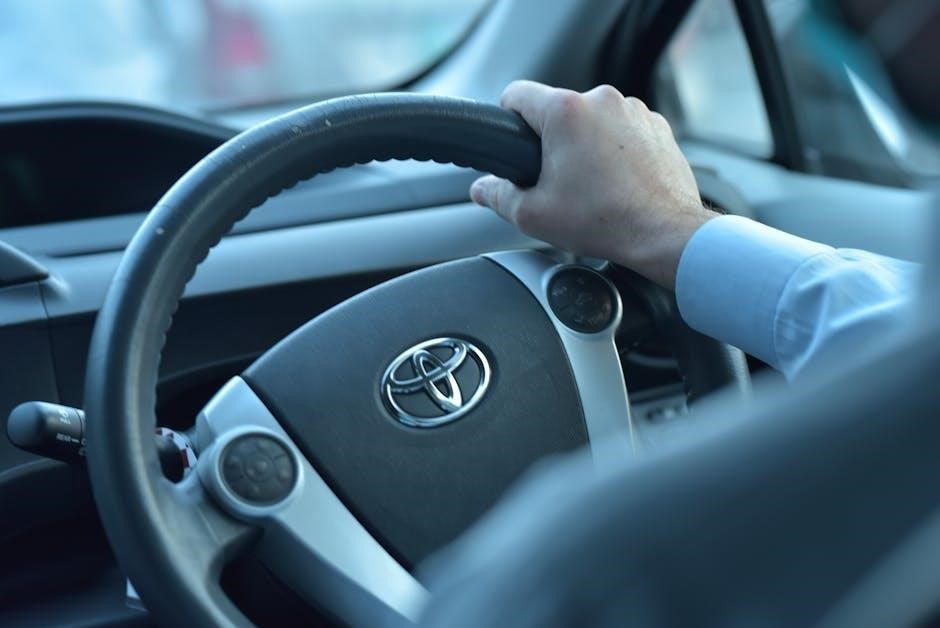A 4-wheel drive (4WD) system powers all four wheels, enhancing traction on challenging surfaces like snow, mud, or gravel. It’s essential for off-road driving and heavy-duty towing.
1.1 Understanding the Basics of 4-Wheel Drive
A 4-wheel drive (4WD) system distributes power to all four wheels, improving traction and control on uneven or slippery surfaces. It’s designed for off-road conditions, heavy-duty towing, or driving in snow, mud, or gravel. Unlike 2WD vehicles, which power only two wheels, 4WD systems can be engaged manually or automatically, depending on the vehicle. Modern systems often feature modes like 4-High (4H) for higher speeds and 4-Low (4L) for maximum torque at low speeds. Understanding how to engage and use these modes correctly is crucial for safe and effective off-road driving; Always check your vehicle’s manual for specific instructions.
1.2 Importance of Knowing How to Engage 4WD
Understanding how to engage 4WD is crucial for safety and vehicle performance. Improper engagement can lead to mechanical damage or loss of control. Always engage 4WD on suitable surfaces like snow, mud, or gravel, as using it on dry pavement can cause binding and wear. Knowing when to switch between modes ensures optimal traction and avoids unnecessary strain. Familiarize yourself with your vehicle’s specific system, as incorrect operation can void warranties or damage components. Proper engagement enhances off-road capability and prevents potential hazards, making it essential for drivers to master this skill.

Preparing to Engage 4-Wheel Drive
Ensure the vehicle is on a suitable surface, check the manual, and familiarize yourself with the 4WD system. Use manual locking hubs if required for proper engagement.
2.1 Familiarizing Yourself with the Vehicle’s 4WD System
Familiarizing yourself with your vehicle’s 4WD system is crucial for proper engagement. Start by understanding the type of 4WD your vehicle has, such as manual locking hubs, electronic shift, or automatic systems. Check the dashboard for indicators like 4WD lights and ensure you know how to interpret them. Locate the controls, such as levers, buttons, or dials, used to engage 4WD. For older models, manual hubs may require physically turning them from “auto” to “lock” before engaging 4WD. Always consult your vehicle’s manual for specific instructions, as procedures can vary significantly between makes and models. Understanding these basics ensures safe and effective 4WD operation.
2.2 Checking the Vehicle’s Manual for Specific Instructions
Consulting your vehicle’s manual is essential for understanding how to engage 4WD correctly. Manuals provide detailed steps tailored to your specific 4WD system, whether it’s manual locking hubs, electronic shift, or automatic. Look for instructions on speed limits for engaging 4WD, such as 35-50 mph for 4-High and stationary or low speeds for 4-Low. Manuals also explain mode switches, hub locking procedures, and dashboard indicators. Familiarize yourself with these guidelines to ensure smooth engagement and avoid potential damage. Proper adherence to manual instructions guarantees safe and effective 4WD operation, tailored to your vehicle’s design.
2.3 Ensuring the Vehicle is on a Suitable Surface
Engaging 4WD requires selecting the right surface to prevent damage and ensure effectiveness. Use 4WD only on loose surfaces like mud, gravel, or deep snow. Avoid dry pavement or grass, as excessive traction can cause binding. The manual often specifies suitable surfaces, so consulting it is advisable. Proper surface selection enhances performance and prevents potential system damage, ensuring safe and effective 4WD operation.

Methods to Engage 4-Wheel Drive
Engaging 4WD can be done manually via locking hubs, electronically with a switch, or automatically through advanced systems. Each method ensures proper traction distribution for varying terrain.
3.1 Manual Locking Hubs
Manual locking hubs require physical engagement by turning the hub locks clockwise to “LOCK” or counterclockwise to “AUTO.” This method ensures front wheels disconnect on paved roads, reducing wear and tear. For 4WD engagement, stop the vehicle, set the transmission to park or neutral, and turn hubs to “LOCK.” Start the engine, shift into 4H or 4L as needed, and check dashboard indicators for confirmation. Proper engagement is crucial to avoid system damage and ensure optimal traction on slippery surfaces like snow or mud.
3.2 Electronic Shift 4WD Systems
Electronic shift 4WD systems offer convenience, allowing drivers to engage 4-wheel drive via a button or knob. To activate, ensure the vehicle is stopped or moving at low speeds. Press the 4WD button, and the system automatically engages, indicated by a dashboard light. For 4-Low, shift to neutral or park, then activate the switch. Modern systems like ESOF provide seamless transitions, optimizing traction on various terrains without manual hub adjustments. Always refer to the vehicle’s manual for specific instructions, as procedures vary by make and model.
3.3 Automatic 4WD Systems

Automatic 4WD systems engage without driver input, providing seamless traction on various surfaces. Sensors monitor wheel slippage and automatically distribute power to all wheels when needed. These systems often combine with advanced technologies like torque vectoring for improved stability. Drivers can override settings if desired, but manual intervention is typically unnecessary. Ensure the vehicle is on a suitable surface, as automatic 4WD excels in conditions requiring constant adaptation. Regular maintenance is crucial to maintain system performance and reliability, ensuring optimal function during challenging driving conditions.

Engaging 4-Wheel Drive While Driving
Engage 4WD while driving by slowing down, ensuring hubs are locked, and using the control lever or button to activate the system smoothly for enhanced traction.
4.1 Steps to Engage 4WD at Low Speeds
When engaging 4WD at low speeds, stop or reduce speed significantly. Ensure the vehicle is on a suitable surface and shift to neutral or park. Lock the hubs manually if required. Use the control lever or button to activate 4WD mode. For low-range, ensure the vehicle is stationary and follow manufacturer instructions. Always refer to the vehicle’s manual for specific steps, as procedures vary by make and model. Proper engagement ensures optimal performance and prevents damage to the system.
4.2 Engaging 4WD While the Vehicle is Moving
Engaging 4WD while moving is possible in some systems, typically at low speeds (up to 35-40 mph). Let off the throttle to reduce speed and ensure wheels are straight. For automatic systems, use the 4WD switch or lever to activate 4H mode; a dashboard light will confirm engagement. In manual systems, shift into neutral or park and engage the transfer case. Avoid sudden movements and ensure the surface allows wheel slippage. Never engage 4WD on dry pavement, as it can cause binding or damage. Always follow the vehicle’s manual for specific instructions.
4.3 Checking for Proper Engagement
After engaging 4WD, check for a dashboard indicator light confirming activation. Listen for mechanical clicks or flashes, indicating proper engagement. Test traction by gently accelerating on a suitable surface. Ensure all wheels are receiving power by observing tire movement or traction improvement. For manual systems, verify hub locks are fully engaged (typically in the “LOCK” position). Avoid driving on dry surfaces with 4WD engaged, as it can cause drivetrain stress or binding. Proper engagement ensures safe and effective performance in challenging conditions.

Understanding 4WD Modes
4WD systems offer modes like 4-High for higher speeds and 4-Low for maximum torque at low speeds, each designed for specific driving conditions and terrain challenges.
5.1 4-High Mode
4-High mode is designed for driving at higher speeds on loose or uneven surfaces, such as snow, gravel, or dirt roads. It provides better traction than 2WD by powering all four wheels while maintaining a higher gear ratio for speed. This mode is ideal for conditions where increased stability and control are needed but does not require the extreme torque of 4-Low. Typically, 4-High can be engaged while the vehicle is moving, often at speeds up to 50 mph, depending on the vehicle. Always ensure the surface allows wheel slippage to prevent binding or damage to the system.
5.2 4-Low Mode
4-Low mode is designed for low-speed, high-torque situations, such as steep inclines, deep mud, or heavy towing. This mode provides maximum traction and control by delivering power to all four wheels with a lower gear ratio. It is typically used when extreme off-road conditions require slower, more deliberate movement. To engage 4-Low, the vehicle must usually be stopped or moving at a very low speed (0-5 mph), and the transmission should be in neutral. After shifting, slight forward movement can help ensure proper engagement. Always use 4-Low on surfaces that allow wheel slippage to avoid system damage.
5.3 When to Use Each Mode
4-High mode is suitable for driving at higher speeds on loose surfaces like gravel or light snow, providing better stability without overloading the system. Engage 4-Low for extreme off-road conditions, such as steep hills, deep sand, or heavy towing, as it offers maximum torque and control at low speeds. Always switch modes only on surfaces allowing wheel slippage to prevent damage. Refer to your vehicle’s manual for specific guidelines to ensure proper usage and maintain the longevity of your 4WD system.

Disengaging 4-Wheel Drive
Stop the vehicle, shift to 2WD mode, and ensure wheels are straight. Avoid sudden movements to protect the drivetrain. Always consult the vehicle’s manual for specific disengagement steps;
6.1 Returning to 2-Wheel Drive
To return to 2-wheel drive, stop the vehicle and shift the transmission to neutral or park. Turn the 4WD selector to the 2WD position. For manual systems, ensure the hubs are in “auto” or “free” mode. Check the dashboard for confirmation lights indicating 2WD engagement. Avoid switching modes on hard surfaces to prevent drivetrain damage. If manual locking hubs are used, turn them counterclockwise until they click into the “auto” position. Always refer to the vehicle’s manual for specific instructions, as procedures may vary. Proper disengagement ensures smooth transitions and prevents potential system damage.
6.2 Disengaging Manual Locking Hubs
To disengage manual locking hubs, ensure the vehicle is stationary and the transmission is in neutral or park. Turn the hub dial counterclockwise until it aligns with the “auto” or “free” position. You may hear a click when it disengages. Avoid turning the hubs while the vehicle is moving, as this can cause damage. For some models, reversing a short distance may be necessary to ensure hubs fully disengage. Always refer to the vehicle’s manual for specific instructions, as improper disengagement can lead to drivetrain issues. Proper hub disengagement ensures smooth transitions back to 2-wheel drive mode.
6.3 Driving in 2-Wheel Drive Mode
Once 4-wheel drive is disengaged, your vehicle reverts to 2-wheel drive mode, which is ideal for normal driving conditions on paved surfaces. Properly disengaging 4WD ensures smooth transitions and prevents drivetrain strain. Always check that manual locking hubs are fully disengaged and set to “auto” or “free” mode. This allows the front wheels to rotate freely without engaging the front axle. Driving in 2-wheel drive improves fuel efficiency and handling on dry roads. Avoid engaging 4WD on dry pavement, as it can cause unnecessary wear and potential binding issues. Always consult your vehicle’s manual for specific guidance on returning to 2WD mode.

Safety Tips and Best Practices
Always engage 4WD on surfaces allowing wheel slippage, avoid sudden movements, and maintain your system regularly for optimal performance and safety.
7.1 Engaging 4WD Only on Suitable Surfaces
Engage 4WD only on surfaces like snow, mud, gravel, or wet environments where traction is limited. Avoid using 4WD on dry pavement, as it can cause drivetrain stress and wheel binding. Always ensure the surface allows some slippage to prevent damage. Check your vehicle’s manual for recommended surfaces and conditions. Proper use ensures safety and extends the system’s lifespan.
- Suitable surfaces: snow, mud, gravel, or wet environments.
- Avoid dry pavement to prevent drivetrain stress.
- Ensure some wheel slippage to avoid binding.
Warning: Never engage 4WD on hard, traction-rich surfaces like dry asphalt, as it can damage the system.
7.2 Avoiding Sudden Movements
Avoid sudden acceleration, sharp turns, or braking when 4WD is engaged, as these can cause drivetrain stress or loss of control. Sudden movements may lead to wheel binding or system damage. Always feather the gas pedal gently and maintain steady control, especially on uneven terrain. This ensures smooth power delivery and optimal traction. Be cautious when transitioning between surfaces to prevent abrupt shifts in torque distribution.
- Use gentle throttle input to avoid drivetrain stress.
- Steer smoothly to prevent sudden torque shifts.
- Brake gradually to maintain control on slippery surfaces.
Remember: Sudden movements can compromise stability and damage the 4WD system.
7.3 Regular Maintenance of the 4WD System
Regular maintenance is crucial for optimal performance and longevity of the 4WD system. Check the transfer case fluid level regularly and replace it as recommended by the manufacturer. Inspect the driveshafts and universal joints for wear or damage. Ensure that all electronic sensors and switches are functioning properly. Lubricate locking hubs and connections to prevent rust and corrosion. Additionally, test the system periodically to ensure all modes engage smoothly. Neglecting maintenance can lead to costly repairs and reduced off-road capability. Stay proactive to keep your 4WD system reliable and efficient.

Troubleshooting Common Issues
Common 4WD issues include failure to engage, grinding noises, or system malfunctions. Check hub locks, transfer case fluid, and electrical connections. Consult the manual for diagnostics. Ensure proper surface conditions and avoid overloading the vehicle. If problems persist, professional assistance may be required to restore functionality and prevent further damage. Regular inspections can help identify and resolve issues early, ensuring reliable operation and extending the system’s lifespan. Addressing problems promptly prevents costly repairs and maintains optimal performance. Always refer to the vehicle’s manual for specific troubleshooting steps tailored to your 4WD system.
8.1 Why 4WD Might Not Engage
Your 4WD system may fail to engage due to manual locking hubs not being in the correct position or issues with the transfer case. Ensure the hubs are set to “lock” and not “auto.” Verify the vehicle is on a suitable surface where some wheel slippage is possible, as 4WD should not be engaged on dry pavement. Check for obstructions or mechanical damage to the hubs and transfer case. Low transfer case fluid levels or electrical faults can also prevent engagement. Always consult your vehicle’s manual for specific troubleshooting steps tailored to your system. If problems persist, seek professional assistance to avoid further damage. Regular maintenance, such as checking and topping off fluids, can help prevent these issues and ensure smooth operation. Addressing these common causes can restore functionality and keep your 4WD system reliable.
8.2 Solving Engagement Failures
If your 4WD fails to engage, start by stopping the vehicle and shifting to neutral or park. Ensure manual locking hubs are fully turned clockwise to the “lock” position. Check the transfer case lever to confirm it’s properly aligned with the 4WD setting. Restart the engine and attempt to engage 4WD again. For electronic systems, verify all dashboard lights illuminate correctly. If issues persist, inspect for loose connections or damaged components. Regularly maintaining the system, including fluid checks and hub lubrication, can prevent future failures. Always refer to your vehicle’s manual for specific repair guidance. If problems remain unresolved, consult a professional mechanic to diagnose and fix the issue, ensuring optimal performance and safety. Addressing these steps can help restore function and prevent further complications.
8.3 Dealing with Binding or Grinding Noises
If you experience binding or grinding noises while engaging 4WD, stop the vehicle immediately. These sounds often indicate improper surface use or mechanical issues. Ensure you’re on a surface allowing wheel slippage, as pavement can cause binding. Next, disengage 4WD and shift back to 2WD. Inspect the hubs and transfer case for damage or misalignment. If noises persist, check for worn or damaged components like gears or bearings. Lubricate moving parts and ensure all connections are secure. If issues remain, consult a professional to diagnose and repair the system, preventing further damage and ensuring safe operation. Regular maintenance can help avoid such problems. Always refer to your vehicle’s manual for specific guidance. Addressing these issues promptly is crucial to maintain the integrity of your 4WD system and avoid costly repairs. If the noise continues, it may indicate a deeper mechanical issue that requires immediate attention to prevent system failure. By taking these steps, you can resolve the issue efficiently and safely.
Advanced Techniques for Off-Roading
Mastering advanced off-roading involves switching between 4-High and 4-Low modes for varying terrain. Use 4-Low for steep inclines and heavy pulling. Rocking the vehicle can help regain traction on slippery surfaces, enhancing control and stability in challenging conditions.
9.1 Switching Between 4-High and 4-Low Modes
Switching between 4-High and 4-Low modes requires careful consideration of terrain and speed. Engage 4-High for higher speeds, such as on gravel roads, while 4-Low is best for low-speed, high-torque situations like steep inclines or deep mud. Always ensure the vehicle is stopped or moving at a very low speed before switching modes. Proper mode selection enhances traction and control, preventing system damage. Practice mode transitions in safe conditions to build familiarity and confidence in off-road driving scenarios.
9.2 Using 4-Low for Steep Inclines
Engaging 4-Low is essential for tackling steep inclines, as it provides maximum torque for better control and traction. Always stop the vehicle on a flat surface, shift into neutral or park, and engage 4-Low before attempting the climb. Ensure the wheels are straight and avoid sudden acceleration to maintain stability. Use 4-Low for descents as well to maintain a slow, controlled speed. Proper use of 4-Low enhances safety and prevents wheel slippage on steep terrain, making it a critical feature for off-road adventures.
9.3 Rocking the Vehicle to Gain Traction
Rocking the vehicle is a technique used to gain traction when stuck in mud, snow, or sand; Engage 4-Low for better control and gently alternate between forward and reverse, using minimal acceleration. This motion helps the tires find grip. Avoid sudden movements to prevent digging deeper. If unsuccessful, consider using traction mats or winching. Always maintain a steady throttle to avoid wheel spin and further loss of traction. This method is effective but requires patience and careful execution to free the vehicle safely.

Vehicle-Specific Instructions
Vehicle-specific instructions are crucial for proper 4WD engagement, varying by make and model, such as Ford F250, Jeep Wrangler, and Toyota 4Runner, each with unique procedures.
10.1 Ford F250 4WD Engagement
To engage 4WD on a Ford F250, stop the vehicle and ensure tires are straight. Shift into neutral, then use the transfer case lever to select 4H or 4L. For manual locking hubs, turn them clockwise to “lock” before engaging 4WD. Once engaged, a dashboard light will confirm activation. Always refer to the owner’s manual for specific instructions tailored to your F250 model. Proper engagement ensures optimal traction and vehicle control in challenging conditions.
10.2 Jeep Wrangler 4WD Engagement
To engage 4WD in a Jeep Wrangler, park the vehicle and shift into neutral. For 4HI mode, pull the transfer case lever toward you until it clicks. For 4LO, stop completely, ensure tires are straight, and shift into neutral before engaging. 4HI can be activated while driving at speeds below 35 mph, while 4LO requires the vehicle to be stationary. Always consult the owner’s manual for model-specific instructions to ensure proper engagement and optimal performance in off-road conditions.
10.3 Toyota 4Runner 4WD Engagement
To engage 4WD in a Toyota 4Runner, start by shifting into neutral and ensuring the vehicle is on a suitable surface. For 4-High mode, pull the transfer case lever toward you until it clicks. For 4-Low, stop completely, shift into neutral, and pull the lever further to engage. Always refer to the owner’s manual for specific instructions, as some models may vary. Proper engagement ensures optimal traction and performance in off-road conditions, while avoiding engagement on paved surfaces prevents potential damage to the system.

No Responses